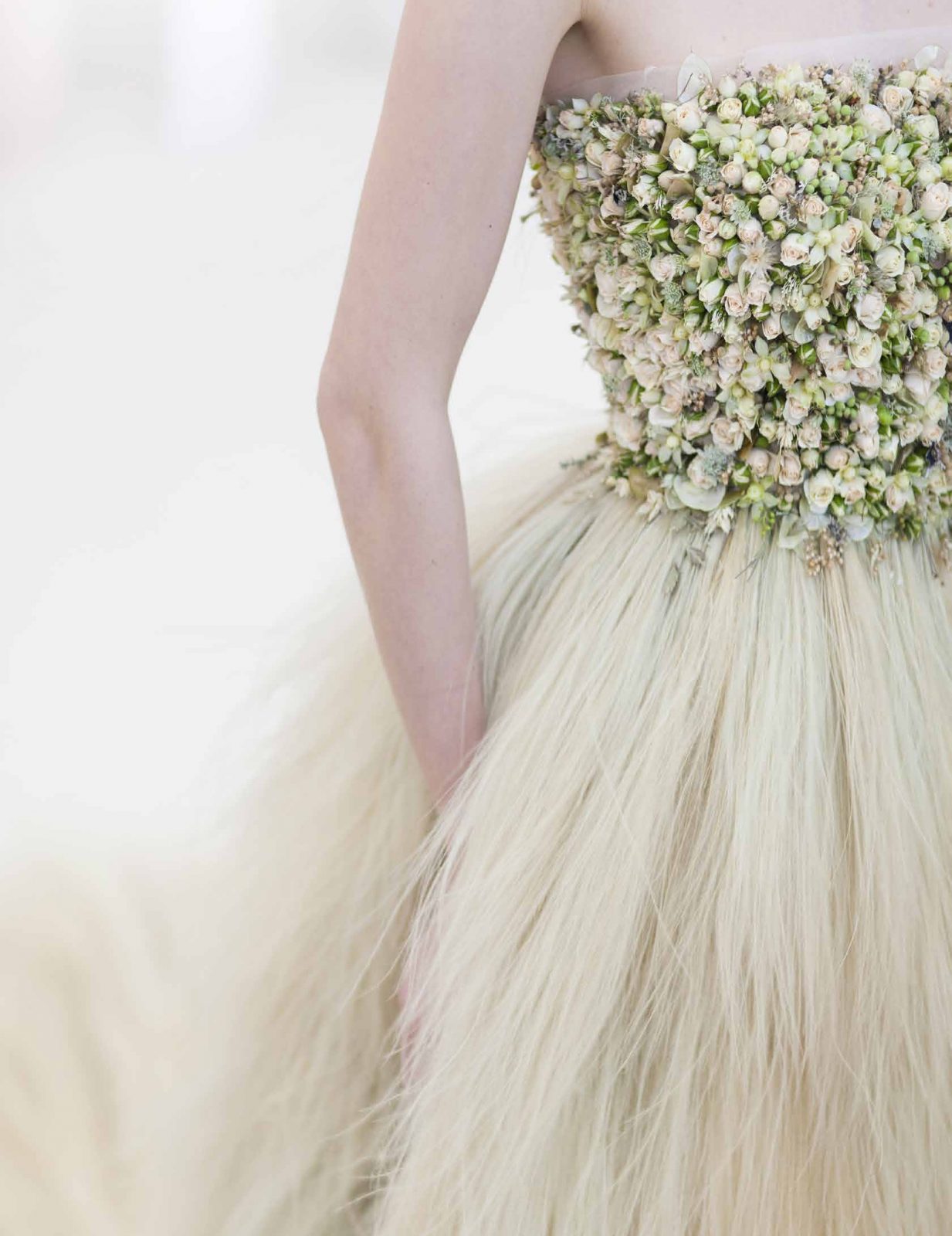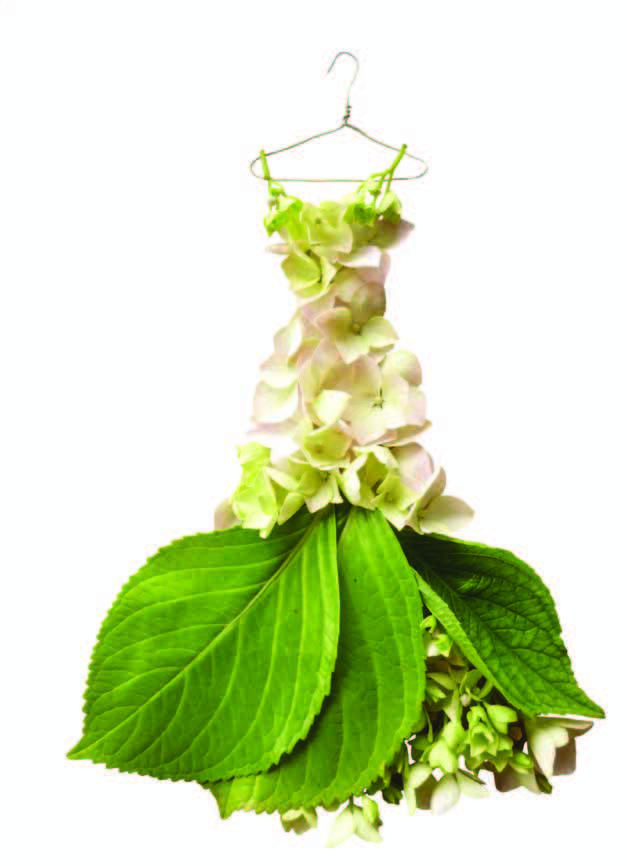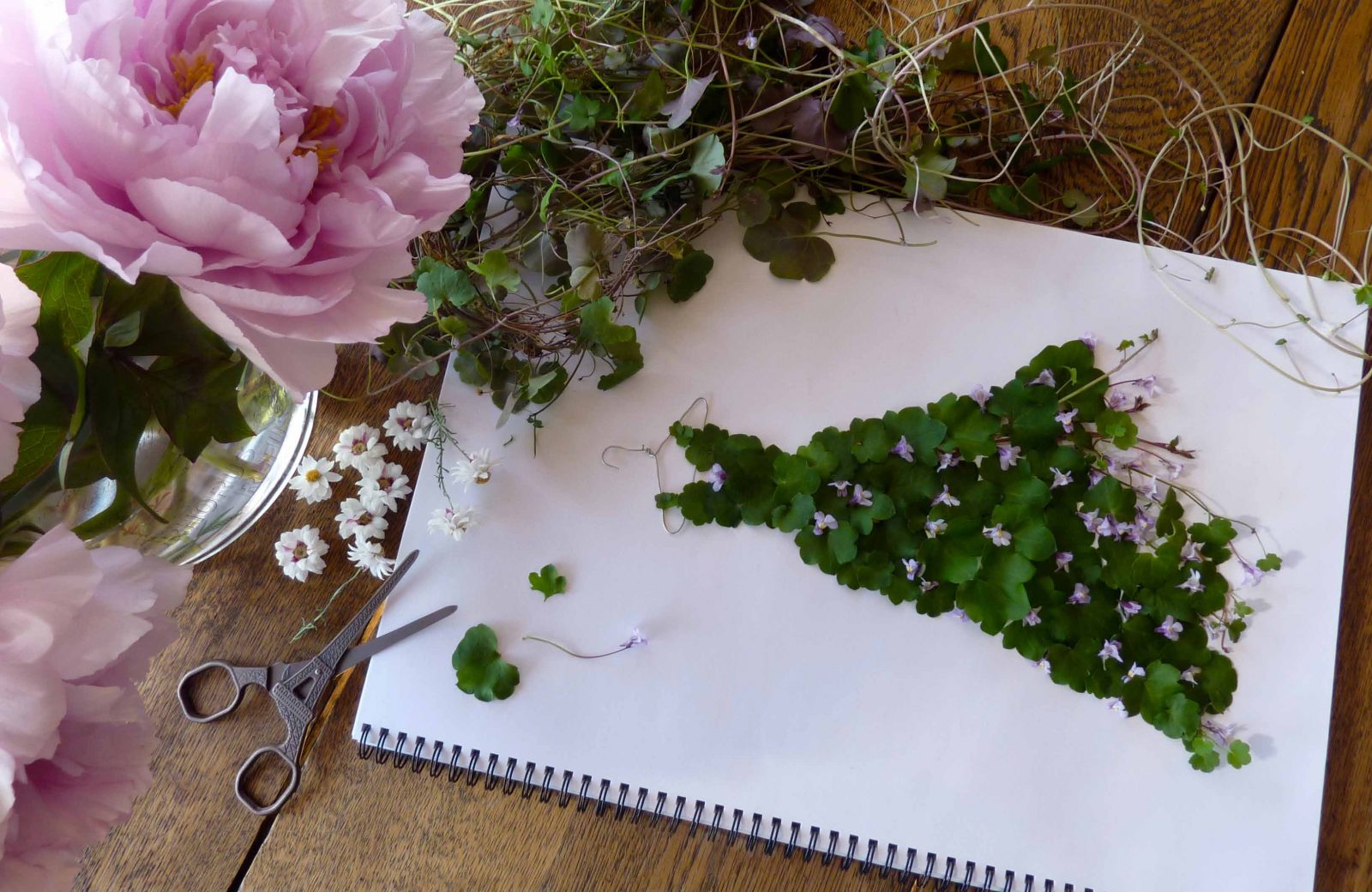A profusion of thriving blooms spill from the waist of her gown to the grass at her feet. Moss spreads across the bodice and one shoulder. Flaring fronds frame her neck and shoulders. It’s a gown fit for Mother Nature herself, but it’s a creation of human (albeit very talented) hands.
These days a number of talented artists are using flowers, moss, and other bits of nature to create extraordinary organic gowns, shoes, purses, and accessories. The life spans of these living garments may vary, but their transitory nature only makes them that much more magical and enchanting. Artists like Sandra Alcorn, who hails from Tasmania, are making gowns from single leaflets and tiny filaments, painstakingly creating tiny and intricate gowns for the smallest of sprightly Thumbelinas. Inspired by the beautiful garden view she saw from her studio window, Alcorn created her first design in a “Garden Fairy’s Wardrobe” series four years ago. Her designs are created for one imagined fairy character, a “social butterfly who requires a variety of garments for her wardrobe.” While her designs are inspired by her work and her garden, “even when I’m traveling I’m thinking about and creating new designs for [my fairy’s] wardrobe. I’ve made seaweed gowns on trips to the coast, and tropical flower dresses from my sister’s garden on Magnetic Island. I love the ephemeral nature of creating the dresses.”

Other organic gowns are meant to be worn for an event, or a series of events. Artists often create a supportive structure and build the garment on it. A few of these creations include their own methods of sustaining the plants—through small vessels for water, a base layer of moss that has been wet down, or sometimes even pots of soil for whole rooted plants. Others have no means of sustenance, but are made from plant materials that are known for having a long life or that have already been dried. Most, if not all, of them will only last so long before, like so much magic, they disappear back into their elements, disintegrating and wilting back into the earth from which they came.

Flower artist Vashti Cassinelli grew up painting pictures of fairies in flower dresses, inspired by Cicely Mary Barker’s work. When she began her business as a florist, her goal was to offer people more wildly and naturally designed wedding flowers using native species. Thinking outside the box comes naturally to her, and her flower hats and dresses helped her live out her childhood fantasies of flower dresses. “I try to think carefully about the ethics of my work and the origins of the flowers despite the ephemeral nature of my couture. My creations are Cinderella-esque and designed to last for the duration of a night or event.” Her rose gown seen in this article used over five hundred scented English roses and was commissioned by the sponsors of the Chelsea Flower Show.

Designer Zita Else was teaching one of her own Concept & Design classes at her Design Academy in Kew, England when she discovered how to translate her signature floral embroidery technique from a glass vase to a piece of material—and she quickly created her first full bridal gown. Now she uses all sorts of delicate plant material for her gowns—rose buds, tiny flower heads, seed heads, seeds, shells … “It’s the blend of textures and the attention to detail that create a magic effect,” she says. She starts work many weeks before a wedding, sketching the dress and making up the material base before sourcing the materials and putting it all together. About a week before, she works with a team of up to five florists to assemble a skirt of skeletonized leaves, or Stipa grass. A couple of days before the wedding, she adds the fresh floral embroidery bodice. Though made for one special, unforgettable day, her gowns can last many months, even years, if kept in dry conditions.

Another type of floral gown may have the longest life, but is never actually meant to be worn. Gowns for your garden, often created on a wire mannequin base, start with a stuffing of peat, moss, and/or other organic material into which various flowers, usually succulents, are placed in a way to form a gown and skirts. The result adds a touch of capricious charm to your garden or outdoor space, as if a faerie Cinderella could be arriving at any moment to claim her organic ball gown.
Pam Yokoyama of 4 Seasons Painting and Landscaping created a beautiful example of this kind of gown from a wire dress form and succulent plants. She began by planning out how many succulent plants would be needed to create each row of the “gown” worn by the dress form. Smaller succulents were used toward the top, and larger ones for the fuller skirt. “Once I had it planned out, I used container soil to plant each succulent in rows going up the dress form. I compacted the soil around the succulents, but I used a thick but pliable wire to attach a large piece of landscape fabric across the bottom of the dress to catch any excess dirt that fell.” Succulents are a wonderful plant to use for this type of project, she says, because they only require water about once per week.

Other artists have even gone beyond the gown to also create gorgeous accessories—purses, shoes, and even umbrellas composed of blossoms and greenery. Some of these are made to be used and worn, some are made more for our imaginations, but all are utterly charming. Françoise Weeks is a Belgian florist who specializes in a unique and textural style. Her line of “Floral Forward” designs of botanical haute couture purses, headpieces, and shoes showcase her years spent honing her craft.
So the next time you take a walk in your garden, or by a meadow’s edge, just imagine you are a magical seam-stress looking out at a shop filled with bolts of cloth, ribbons, and trims. Perhaps the next Mother Nature masterpiece will be of your own design!
Article from Issue #27 Summer 2014
Subscribe // Order Back Issues


































